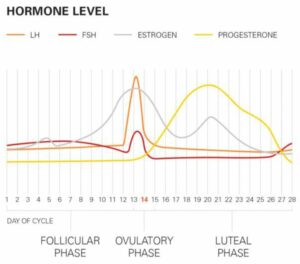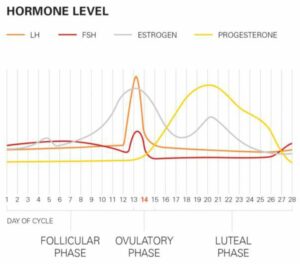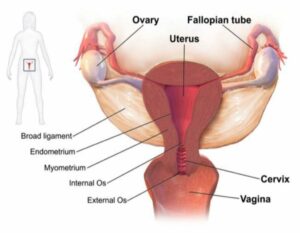The Menstrual Cycle
What is a Menstrual Cycle?
The menstrual cycle is the monthly series of changes that a woman’s reproductive system undergoes in order to be prepared for a possible pregnancy.
One cycle is from the start of bleeding (period) to the start of the next period and is roughly (give or take a few days) consistent each month.
There are 4 main hormones that fluctuate in level during the cycle, which control the menstrual cycle:
- oestrogen (produced in the ovary)
- progesterone (produced by the unfertilised ‘egg’ or ‘ovum’)
- follicle-stimulating hormone (FSH) (produced by the brain)
- luteinizing hormone (LH) (produced by the brain)

What causes the Menstrual Cycle?
- Day one of a cycle is considered the first day of a period. At this point all the bodies hormones are at a low level.
- Oestrogen levels then increase, to stimulate egg production in the ovary (this is known as the follicular phase of the cycle).
- Once oestrogen reaches a certain level, and the egg is ready to be released from the ovary, LH sharply rises. This sharp rise causes the egg to be released from the ovary (this is called ovulation and occurs at about the middle of a cycle).
- After ovulation, oestrogen, LH and FSH levels decline and progesterone starts to rise.
- Progesterone continues to thicken the lining of the uterus wall (the ‘endometrium’) to receive a fertilised egg (this is known as the ‘follicular’ phase of the cycle).
- If the egg isn’t fertilised, then the progesterone level falls, and the endometrium ‘comes off’ the uterus wall. This is the period (also known as menses).
How Long is a Menstrual Cycle?
- A menstrual cycle between 21 and 36 days is considered normal.
- Many women don’t have exactly the same number of days in each cycle. 2 or 3 days on either side is common. However, a week or more on either side does suggest an irregular cycle.
- Menstrual cycle length normally remains quite steady for an individual woman from about 2-3 years after periods start until the menopausal transition, with the exception of pregnancy.
When do periods start?
- Periods usually start anywhere from age 9 to 16.
- Breast budding is the most common first sign of puberty. Periods will start about 2 years after breast budding starts.
- It is very common and normal to have an irregular cycle shortly after periods start. This cycle irregularity can last for 2 years but then will typically develop into a regular cycle.
- If your periods haven’t started either before age 16 or within 3 years of breast budding, follow up with a General Practitioner (GP) is recommended.
How Long and Heavy is a Period?
- This varies between individuals.
- The length of periods may vary, but 3-7 days is typical.
- The amount of bleeding during a period varies. Some women don’t need much more than a liner, while others may need a super tampon changed every couple of hours – particularly in the first 2 days.
- Heavy bleeding (menorrhagia) is defined as greater than 80ml per day. Changing a super tampon and/or a thick pad every 2 hours or waking at night to regular flooding would be consistent with menorrhagia.
- Small clots are normal but bigger clots are not.
- Large clots and flooding should both be followed up with a GP.
How painful are periods?
- Most women get some discomfort, but a period shouldn’t stop you from doing anything.
- Should a period be so painful that you miss school, study or training then it may be time to see a doctor. The pain of periods is known as dysmenorrhoea.
- Period pain is the result of chemicals causing the muscles of the uterus to contract, thereby squeezing the endometrium out of the uterus.
- Exercise can help dysmenorrhoea.
What is Premenstrual Syndrome (PMS)?
- PMS describes cyclical symptoms that start several days before a period, and typically resolve with the onset of menstruation. Symptoms can include abdominal bloating, breast soreness, mood swings, increased hunger, increased thirst and acne. Not everyone experiences PMS and the range of symptoms is enormous.
- PMS usually finishes within 1-2 days of the period starting.
- Adequate sleep and exercise are the most effective treatment.
Periods for Performance
Why Periods are Important?
Having a regular period is a visible sign of a female’s hormonal health, and usually signifies a good energy balance. Having regular periods is a good guide to the readiness for training and performance.
A regular menstrual cycle or period is considered as having a period every 28 – 35 days – from the first day of one period, to the start of a second.
Commonly, cycles can be irregular in their first 2 years but usually become regular with time and settle into a consistent pattern.

What does it mean when periods are missed?
When women miss more than 3 periods in a row this is known as Amenorrhoea.
- Primary amenorrhoea is when periods haven’t started by age 15 years.
- Secondary amenorrhoea is when periods have started, but then they stopped.
When women have only 6 – 9 periods in a year, or the length of cycles is more than 35 days, this is known as Oligomenorrhoea.
The most common cause of amenorrhea or oligomenorrhea in athletes is ‘functional hypothalamic amenorrhoea’ (FHA), which means that a woman’s body isn’t producing hormones as expected, and therefore periods are affected. In athletes, this usually results from not having enough energy intake (food) for the amount of exercise/training being performed (energy output).
While common, missing periods as a result of FHA is neither normal nor optimal from a health, training, recovery or performance perspective. Inadequate energy intake (from food), hormonal imbalance and the absence of periods can have negative effects on training, bone health and the risk of infection.
Other common causes of oligomenorrhoea or amenorrhoea include thyroid gland dysfunction, polycystic ovarian syndrome and pregnancy.
What is Functional Hypothalamic Amenorrhea?
The hypothalamus and pituitary gland are areas of the brain that produce chemicals called hormones. Those hormones circulate in the blood and affect the way the ovaries are working and are critical to having ‘normal’ cycles of periods.
Stress, in any form, can change the release of hormones from the hypothalamus and pituitary gland, and cause amenorrhoea.
The most common stress in athletes that affects the production of hormones, is a lack of energy balance.
When athletes don’t eat enough food (energy) to allow for exercise levels, recovery and all the other functions of the body, hormone production is reduced, and periods may cease.
Intense exercise on its own does not stop periods – if there is enough food consumed (energy-in) to meet the bodies requirements (energy-out).
What to do when periods are not regular?
If an athlete’s cycle of periods (menstrual cycle) has changed, or does not fit with the pattern described above, a general practitioner (GP), Sports Doctor/Physician or Sport Medical Director should be consulted.
A Doctor will want to understand the woman’s medical history, perform an examination, take some blood tests (including hormone levels) and, sometimes, perform a pelvic ultrasound scan.
Treatment will depend on the underlying cause of the change in the menstrual cycle but may involve a nutritionist, physiologist, and psychologist, in addition to a medical doctor.
Managing the Painful Period in Sport
Pain and cramping that occurs during periods is known as dysmenorrhoea.
Often symptoms start around the beginning of a menstrual period and may last 3-4 days.
Pain is usually localised to the lower belly, back or upper legs and tends to be a deep ache, often with a feeling of pressure.
With the pain, there may also be nausea/vomiting, fatigue and even diarrhoea.
What Causes Dysmenorrhoea?
A hormone (prostaglandin) is released during the menstrual period that causes the uterus (womb) to contract (cramp). The cramp may cut off the blood and oxygen supply to the muscle of the uterus, causing pain.
Primary Dysmenorrhoea
This refers to common menstrual pain and cramps, when no disease is present.
Primary dysmenorrhoea is common in young women and often improves with age and/or after childbirth.
Secondary Dysmenorrhoea
By contrast, secondary dysmenorrhoea results from an abnormality of some part of the reproductive organs.
While the nature of the pain is often similar to primary dysmenorrhea, the pain may start earlier in the cycle before menstruation begins, lasts for longer and it doesn’t tend to have associated symptoms.
Secondary dysmenorrhoea is more common in older women.
Common causes of secondary dysmenorrhea include:
- Endometriosis: when the internal uterine lining (known as the endometrium) is found outside the uterus, such as on the bowel, ovaries or other organs
- Adenomyosis: when the internal uterine lining grows into the deeper layers of muscle in the uterus wall
- Fibroids: benign growths in the muscular wall of the uterus

Should I be worried about period pain?
It is not normal for period pain and cramps to be so bad as to not be able to attend, or effectively perform, schoolwork, study, work, or training.
If pain during a period is affecting study, work or training, it is important to consult a General Practitioner, Sports Doctor/Physician or Sport Medical Director.
A Doctor will want to understand the woman’s medical history, perform an examination, take some blood tests (including hormone levels), and sometimes perform a pelvic ultrasound scan.
There is a range of treatment options including getting the right pain relief, using hormonal medication, or other interventions depending on the cause of the dysmenorrhea.
What can be done to help during painful periods?
Simple ways of minimising the pain of periods include:
- Applying a heat pack to the lower back or belly
- Rest or exercise (everyone responds differently)!
- Avoid or minimise intake of caffeine, alcohol or smoking (always)
- Gentle massage to the lower back
- Over the counter medication:
- Pain relief such as paracetamol or ibuprofen – take regularly and start prior to pain becoming very severe
- Regular paracetamol (2 tablets every 4 hours, maximum of 4 times in 24 hours) will help other pain relief be more effective
- Remember, as ibuprofen is an antiinflammatory it must be taken with food (usual dose 200mg-400mg up to three times daily)
